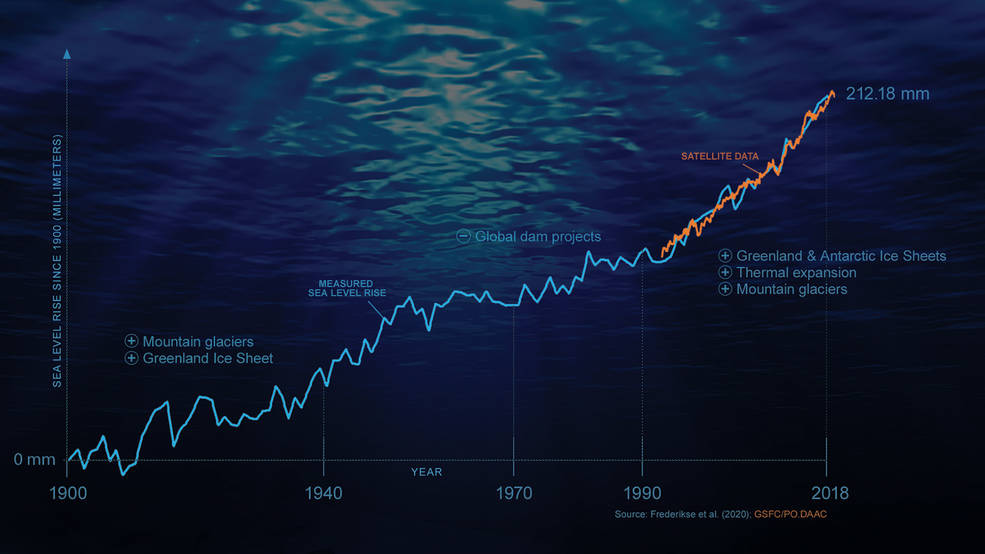import earthaccess
import xarray as xr
from pyproj import Geod
import numpy as np
import hvplot.xarray
from matplotlib import pyplot as plt
from pprint import pprintAnalyzing Sea Level Rise with NASA Earthdata

Overview
This tutorial analyzes global sea level rise from satellite altimetry data and compares it to a historic record. We will be reproducing the plot from this infographic: NASA-led Study Reveals the Causes of Sea Level Rise Since 1900.
Learning Objectives
- Search for data programmatically using keywords
- Access data within the AWS cloud using the
earthaccesspython library - Visualize sea level rise trends from altimetry datasets and compare against historic records
Requirements
1. Compute environment - This notebook can only be run in an AWS Cloud instance running in the us-west-2 region.
2. Earthdata Login
An Earthdata Login account is required to access data, as well as discover restricted data, from the NASA Earthdata system. Thus, to access NASA data, you need Earthdata Login. Please visit https://urs.earthdata.nasa.gov to register and manage your Earthdata Login account. This account is free to create and only takes a moment to set up.
Install Packages
We recommend authenticating your Earthdata Login (EDL) information using the earthaccess python package as follows:
auth = earthaccess.login(strategy="netrc") # works if the EDL login already been persisted to a netrc
if not auth.authenticated:
# ask for EDL credentials and persist them in a .netrc file
auth = earthaccess.login(strategy="interactive", persist=True)You're now authenticated with NASA Earthdata Login
Using token with expiration date: 09/10/2023
Using .netrc file for EDLSearch for Sea Surface Height Data
Let’s find the first four collections that match a keyword search for Sea Surface Height and print out the first two.
collections = earthaccess.collection_query().keyword("SEA SURFACE HEIGHT").cloud_hosted(True).get(4)
# Let's print 2 collections
for collection in collections[0:2]:
# pprint(collection.summary())
print(pprint(collection.summary()), collection.abstract(), "\n", collection["umm"]["DOI"], "\n\n"){'cloud-info': {'Region': 'us-west-2',
'S3BucketAndObjectPrefixNames': ['podaac-ops-cumulus-public/SEA_SURFACE_HEIGHT_ALT_GRIDS_L4_2SATS_5DAY_6THDEG_V_JPL2205/',
'podaac-ops-cumulus-protected/SEA_SURFACE_HEIGHT_ALT_GRIDS_L4_2SATS_5DAY_6THDEG_V_JPL2205/'],
'S3CredentialsAPIDocumentationURL': 'https://archive.podaac.earthdata.nasa.gov/s3credentialsREADME',
'S3CredentialsAPIEndpoint': 'https://archive.podaac.earthdata.nasa.gov/s3credentials'},
'concept-id': 'C2270392799-POCLOUD',
'file-type': "[{'Format': 'netCDF-4', 'FormatType': 'Native', "
"'AverageFileSize': 9.7, 'AverageFileSizeUnit': 'MB'}]",
'get-data': ['https://cmr.earthdata.nasa.gov/virtual-directory/collections/C2270392799-POCLOUD',
'https://search.earthdata.nasa.gov/search/granules?p=C2270392799-POCLOUD'],
'short-name': 'SEA_SURFACE_HEIGHT_ALT_GRIDS_L4_2SATS_5DAY_6THDEG_V_JPL2205',
'version': '2205'}
None This dataset provides gridded Sea Surface Height Anomalies (SSHA) above a mean sea surface, on a 1/6th degree grid every 5 days. It contains the fully corrected heights, with a delay of up to 3 months. The gridded data are derived from the along-track SSHA data of TOPEX/Poseidon, Jason-1, Jason-2, Jason-3 and Jason-CS (Sentinel-6) as reference data from the level 2 along-track data found at https://podaac.jpl.nasa.gov/dataset/MERGED_TP_J1_OSTM_OST_CYCLES_V51, plus ERS-1, ERS-2, Envisat, SARAL-AltiKa, CryoSat-2, Sentinel-3A, Sentinel-3B, depending on the date, from the RADS database. The date given in the grid files is the center of the 5-day window. The grids were produced from altimeter data using Kriging interpolation, which gives best linear prediction based upon prior knowledge of covariance.
{'DOI': '10.5067/SLREF-CDRV3', 'Authority': 'https://doi.org'}
{'cloud-info': {'Region': 'us-west-2',
'S3BucketAndObjectPrefixNames': ['nsidc-cumulus-prod-protected/ATLAS/ATL21/003',
'nsidc-cumulus-prod-public/ATLAS/ATL21/003'],
'S3CredentialsAPIDocumentationURL': 'https://data.nsidc.earthdatacloud.nasa.gov/s3credentialsREADME',
'S3CredentialsAPIEndpoint': 'https://data.nsidc.earthdatacloud.nasa.gov/s3credentials'},
'concept-id': 'C2753316241-NSIDC_CPRD',
'file-type': "[{'FormatType': 'Native', 'Format': 'HDF5', "
"'FormatDescription': 'HTTPS'}]",
'get-data': ['https://search.earthdata.nasa.gov/search?q=ATL21+V003'],
'short-name': 'ATL21',
'version': '003'}
None This data set contains daily and monthly gridded polar sea surface height (SSH) anomalies, derived from the along-track ATLAS/ICESat-2 L3A Sea Ice Height product (ATL10, V6). The ATL10 product identifies leads in sea ice and establishes a reference sea surface used to estimate SSH in 10 km along-track segments. ATL21 aggregates the ATL10 along-track SSH estimates and computes daily and monthly gridded SSH anomaly in NSIDC Polar Stereographic Northern and Southern Hemisphere 25 km grids.
{'DOI': '10.5067/ATLAS/ATL21.003'}
Access Data
The first dataset looks like it contains data from many altimetry missions, let’s explore a bit more! We will access the first granule of the SEA_SURFACE_HEIGHT_ALT_GRIDS_L4_2SATS_5DAY_6THDEG_V_JPL2205 collection in the month of May for every year that data is available and open the granules via xarray.
granules = []
for year in range(1990, 2019):
granule = earthaccess.granule_query().short_name("SEA_SURFACE_HEIGHT_ALT_GRIDS_L4_2SATS_5DAY_6THDEG_V_JPL2205").temporal(f"{year}-05", f"{year}-06").get(1)
if len(granule)>0:
granules.append(granule[0])
print(f"Total granules: {len(granules)}") Total granules: 26%%time
ds_SSH = xr.open_mfdataset(earthaccess.open(granules), chunks={})
ds_SSH Opening 26 granules, approx size: 0.0 GB
CPU times: user 5.79 s, sys: 846 ms, total: 6.64 s
Wall time: 24.9 s<xarray.Dataset>
Dimensions: (Time: 26, Longitude: 2160, nv: 2, Latitude: 960)
Coordinates:
* Longitude (Longitude) float32 0.08333 0.25 0.4167 ... 359.6 359.8 359.9
* Latitude (Latitude) float32 -79.92 -79.75 -79.58 ... 79.58 79.75 79.92
* Time (Time) datetime64[ns] 1993-05-03T12:00:00 ... 2018-05-02T12:...
Dimensions without coordinates: nv
Data variables:
Lon_bounds (Time, Longitude, nv) float32 dask.array<chunksize=(1, 2160, 2), meta=np.ndarray>
Lat_bounds (Time, Latitude, nv) float32 dask.array<chunksize=(1, 960, 2), meta=np.ndarray>
Time_bounds (Time, nv) datetime64[ns] dask.array<chunksize=(1, 2), meta=np.ndarray>
SLA (Time, Latitude, Longitude) float32 dask.array<chunksize=(1, 960, 2160), meta=np.ndarray>
SLA_ERR (Time, Latitude, Longitude) float32 dask.array<chunksize=(1, 960, 2160), meta=np.ndarray>
Attributes: (12/21)
Conventions: CF-1.6
ncei_template_version: NCEI_NetCDF_Grid_Template_v2.0
Institution: Jet Propulsion Laboratory
geospatial_lat_min: -79.916664
geospatial_lat_max: 79.916664
geospatial_lon_min: 0.083333336
... ...
version_number: 2205
Data_Pnts_Each_Sat: {"16": 780190, "1001": 668288}
source_version: commit dc95db885c920084614a41849ce5a7d417198ef3
SLA_Global_MEAN: -0.027657876081274502
SLA_Global_STD: 0.0859016072308609
latency: finalPlot Sea Level Anomalies
ds_SSH.SLA.hvplot.image(y='Latitude', x='Longitude', cmap='viridis')